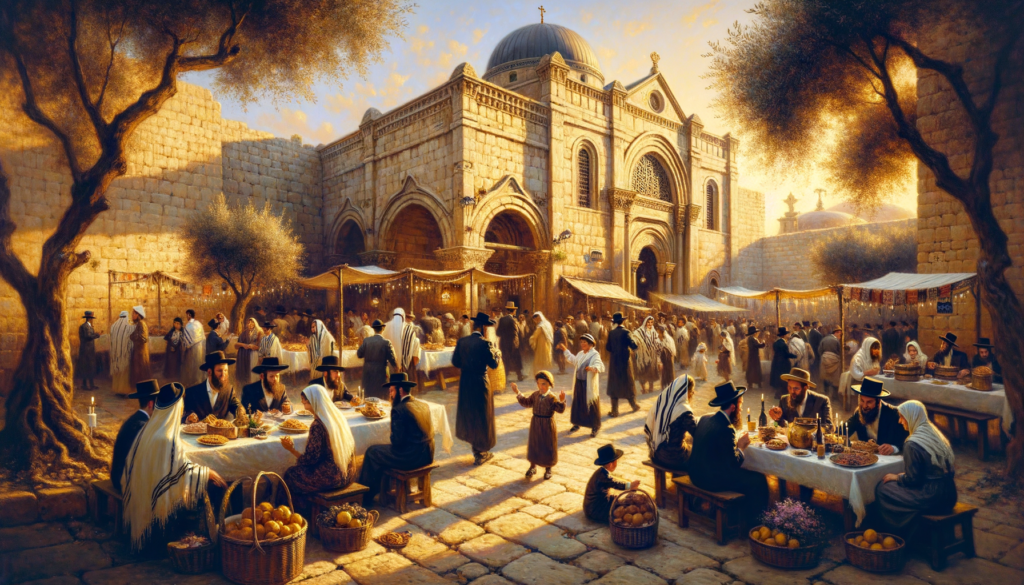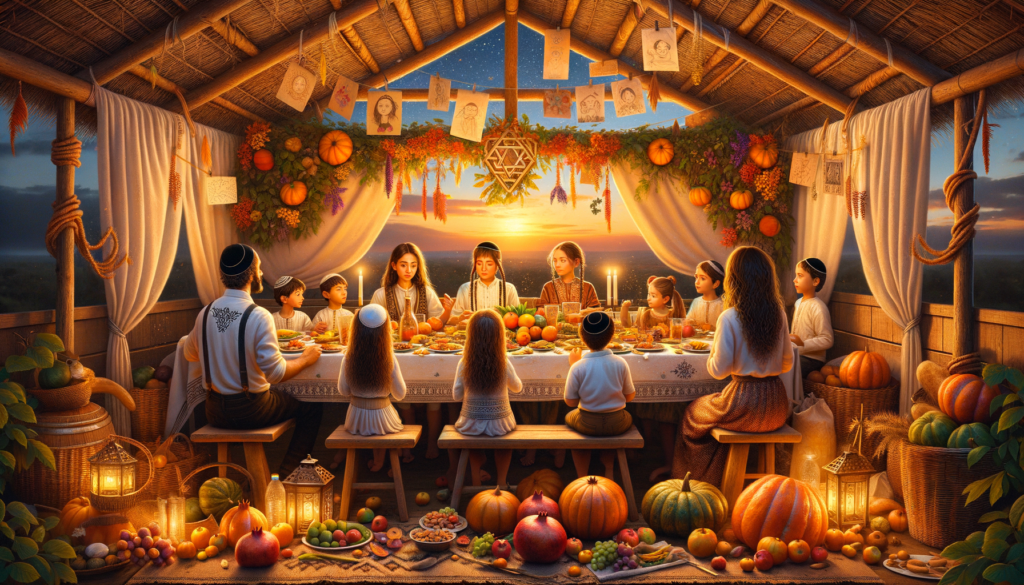A Feast of Joy: The Heartwarming Food Traditions of Sukkot

There is a magic to the autumn air in Israel, a time when the intense summer heat softens into a golden glow, and a spirit of profound joy and gratitude settles over the land. This is the season of Sukkot, the beautiful Feast of Tabernacles. It is a time to step outside, to connect with nature, and to remember a history of wandering and divine protection. At the very heart of this week-long celebration is the act of sharing meals with loved ones in a sukkah, a temporary, three-sided dwelling with a roof of branches open to the stars. The food we eat during this festival is more than just sustenance; it is a story on a plate, rich with the symbolism of the harvest, of being embraced by love, and of the simple, deep joy of togetherness. Join me in my kitchen as I share some of these heartwarming food traditions, traditions that turn a simple meal into a celebration of heritage and hope.
The Heart of the Celebration: Feasting in the Sukkah
Before we even talk about the food itself, we must picture where it is eaten. The sukkah is the centerpiece of the holiday. It is a humble, temporary structure that families build in their gardens or on their balconies. Its roof, made of branches and leaves (s’chach), must be sparse enough to see the stars through, reminding us of the fragile huts the Israelites lived in during their forty years in the desert. This act of ‘dwelling’ outside connects us to our ancestors’ journey and their reliance on divine providence. The sukkah is decorated with love, hung with children’s artwork, colorful ribbons, and the fruits of the harvest—pomegranates, gourds, and strings of figs. To eat in the sukkah is the central commandment of the holiday. Every meal, from a simple morning coffee to a grand festive dinner, becomes a special event. The experience is multisensory: the scent of pine from the roof, the feel of the cool evening breeze, the taste of a warm, comforting meal. It is this beautiful, immersive experience that makes Sukkot’s food traditions so incredibly special and memorable.
A Taste of the Land: The Symbolism of Harvest Foods
Sukkot is, at its core, a harvest festival, known in the Bible as Chag Ha’Asif, the ‘Festival of Ingathering.’ It marks the end of the agricultural year in Israel, a time when the last of the fruits, olives, and grapes were brought in from the fields. It is a moment to give thanks for the earth’s bounty. Naturally, the food served reflects this theme, with an emphasis on fresh, seasonal ingredients that celebrate the richness of the land. Many meals are built around the ‘Seven Species’ (Shivat HaMinim) for which the land of Israel is praised in the book of Deuteronomy. These are wheat, barley, grapes, figs, pomegranates, olives (as in, olive oil), and dates (as in, date honey). Incorporating these ingredients into the Sukkot menu is a beautiful way to connect with the biblical description of a blessed and fertile land. A challah made with wheat and barley, a dish drizzled with olive oil and date syrup, and a dessert adorned with figs and pomegranate seeds—each element on the plate becomes a quiet prayer of gratitude.
The pomegranate is particularly beloved during this season, its jewel-like seeds bursting with juice and symbolism. The round, heavy fruit represents abundance and righteousness. The gourds and squashes of autumn also play a dual role. They are not only cooked into delicious, warming soups and roasted side dishes, but they are also used to decorate the sukkah, their earthy colors and shapes adding to the festive, natural atmosphere. Cooking with these harvest ingredients is a way to align our tables with the rhythm of the land, celebrating the specific gifts of this joyful season.
An Embrace on a Plate: The Tradition of Stuffed Foods
One of the most beautiful and widespread culinary traditions of Sukkot is the eating of stuffed foods. This tradition is found across Jewish communities, from the Ashkenazi kreplach (stuffed dumplings) to the Sephardic and Mizrahi art of stuffing vegetables, like peppers, zucchini, cabbage leaves, or grape leaves. The symbolism behind this is profoundly touching. The outer layer of the food, which envelops the filling, is seen as a representation of a divine embrace, of being surrounded by love and protection. It is a culinary metaphor for the sukkah itself, which envelops and protects us during the holiday. Each bite of a stuffed cabbage roll or a delicate kreplach is a taste of this feeling of being held and cared for.
This tradition allows for incredible creativity in the kitchen. A classic dish is stuffed peppers, where hollowed-out bell peppers are filled with a savory mixture of rice, ground meat (or lentils for a vegetarian version), herbs, and spices, then simmered in a rich tomato sauce until tender. Cabbage rolls, known as holishkes in Yiddish, involve a similar concept, with blanched cabbage leaves wrapped around a delicious filling. In many Sephardic homes, you will find an array of small, artfully stuffed vegetables, a testament to the patience and love that goes into holiday cooking. Making these dishes is often a communal, multi-generational affair, with grandmothers, mothers, and children gathering in the kitchen to roll, stuff, and simmer together, filling the home with incredible aromas and creating lasting memories.
Special Holiday Dishes and Sweet Treats
Beyond the big themes of harvest and stuffed foods, there are other special culinary traditions that adorn the Sukkot table. The challah, the braided bread central to any festive Jewish meal, often takes on a special form. Instead of the usual long braid, the Sukkot challah may be round, symbolizing the cyclical nature of life and the seasons. It is sometimes baked in a spiral or ladder shape, representing the prayers that ascend to the heavens. To further honor the harvest theme, the challah is often topped with a sprinkle of seeds, like sesame or poppy.
One of the most unique traditions involves the etrog, the fragrant citron that is one of the ‘Four Species’ used in a ritual of waving and blessing during the holiday. This beautiful, lumpy citrus fruit is too bitter to be eaten raw, but it is not wasted. After the holiday concludes, many families have the wonderful tradition of turning the etrog into a delicious confection. They candy the peel, make a fragrant jam or marmalade, or even infuse its zest into liqueur. This beautiful act transforms a ritual object into a culinary treat, ensuring that its blessing and fragrance continue to bring joy to the family long after the sukkah has been taken down. It is a perfect example of how in Jewish tradition, the sacred and the everyday are lovingly intertwined.
The food of Sukkot is a story of joy, gratitude, and a deep, abiding connection to our heritage and the land. It is a reminder that the simplest things—a meal shared under the stars, a fruit picked from a tree, a recipe passed down from a grandmother—are often the most meaningful. At Lev Haolam, we feel so privileged to be able to share a small piece of this story with you. The olive oil, the spices, the date honey, and the other artisanal treasures in your box are the very ingredients that fill Israeli kitchens during this festive season. They are a tangible link to the families who tend the land and keep these beautiful traditions alive. As you use them in your own cooking, we hope you feel the warmth and joy of a Sukkot feast, a taste of the harvest from the heart of Israel.




